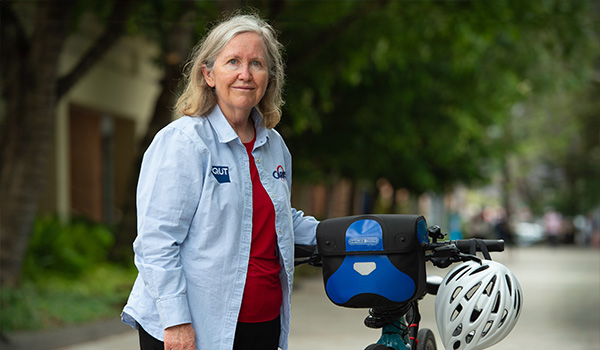As a commuter cyclist, Professor Narelle Haworth has been on the end of vile verbal abuse, had a water bottle thrown at her and been knocked by a car at low speed.
She knows to be wary of trucks and blind spots in their vision and follows the safest route on her commute, not necessarily the most direct one.
Travelling 6km to and from work each day to QUT’s Centre for Accident Research and Road Safety – Queensland (CARRS-Q), Professor Haworth knows firsthand the many safety issues facing cyclists. Cycling to work has also given the long-term RACQ member a unique perspective into her job as a road safety researcher with more than 30 years’ experience, focusing on vulnerable road users – pedestrians, bicyclists, motorcyclists and e-scooter riders.
“I know what it’s like on the roads and why some cyclists can get quite angry when drivers do the wrong thing,’’ Professor Haworth said.
“Your heart rate goes up, your life is in danger. And you can respond inappropriately if you’re not careful.
“It is certainly easier to be interested in a topic if it’s something that affects you as well. If you don’t care about something, why would you work in it for so many years?’’

While falling under QUT’s Faculty of Health, Professor Haworth said CARRS-Q had succeeded, because it took in a range of disciplines that were needed to address road safety.
“Road safety is not a job for psychology, nor is it a job for engineering or for medicine or for statistics,’’ she said.
“It’s a real-world problem that needs a range of people from a range of disciplines who are committed to solving the problem.’’
Professor Haworth has been a policy advisor at state, national and international levels, with appointments on international committees, which have given CARRS-Q and QUT wide recognition. Her research has had an impact on road safety legislation and policy in Queensland and across Australia, including changes to motorcycle and car driver licensing, cycling safety, policing and rail level crossing safety.
Professor Haworth’s review of bicycle helmet research in 2010 helped retain mandatory helmet-wearing laws in the face of strong political pressure.
She dug in and fought hard to keep helmet laws, butting up against moves to relax the rules when Brisbane’s (now scrapped) City Cycle scheme was introduced.
In 2015, Professor Haworth’s husband, Andrew, fell from his bike and landed on his head, spending a month in hospital suffering concussion as well as a broken vertebra, jaw and finger.
“He just lost control and landed on his head on the concrete,” she said.
“If he hadn’t been wearing the helmet, he’d be gone. It’s not why I do what I do, but it makes it personal. It’s something that reminds me of why I do it and why it’s important to keep going.’’
Looking ahead, Australian governments have committed to zero deaths and serious injuries on our roads by 2050.
Professor Haworth said the target was achievable, but much work needed to be done, including reducing default speed limits on rural roads from 100km/h to 80km/h or lower, and in urban areas from 50km/h to as low as 30km/h.
“Australia used to be a leader in road safety internationally,’’ she said.
“We are now number 20 in road safety performance. We get pleased when we bring limits down from 60km/h to 50km/h but, in most parts of the world where there are lots of pedestrians and cyclists, it’s 30km/h. And we know at that level we can get it (fatalities and serious injuries) down to zero.”
He just lost control and landed on his head on the concrete. If he hadn’t been wearing the helmet, he’d be gone.




